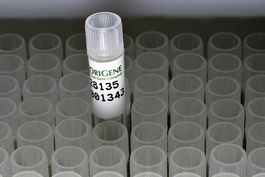Cathepsin S (CTSS) (NM_001199739) Human Tagged ORF Clone
CAT#: RG233630
- TrueORF®
CTSS (GFP-tagged) - Homo sapiens cathepsin S (CTSS), transcript variant 2
"NM_001199739" in other vectors (2)
Product Images

Other products for "CTSS"
Specifications
| Product Data | |
| Type | Human Tagged ORF Clone |
| Tag | TurboGFP |
| Symbol | CTSS |
| Synonyms | FLJ50259; MGC3886 |
| Vector | pCMV6-AC-GFP |
| E. coli Selection | Ampicillin (100 ug/mL) |
| Mammalian Cell Selection | Neomycin |
| Sequence Data |
>RG233630 representing NM_001199739
Red=Cloning site Blue=ORF Green=Tags(s) TTTTGTAATACGACTCACTATAGGGCGGCCGGGAATTCGTCGACTGGATCCGGTACCGAGGAGATCTGCC GCCGCGATCGCC ATGAAACGGCTGGTTTGTGTGCTCTTGGTGTGCTCCTCTGCAGTGGCACAGTTGCATAAAGATCCTACCC TGGATCACCACTGGCATCTCTGGAAGAAAACCTATGGCAAACAATACAAGGAAAAGAATGAAGAAGCAGT ACGACGTCTCATCTGGGAAAAGAATCTAAAGTTTGTGATGCTTCACAACCTGGAGCATTCAATGGGAATG CACTCATACGATCTGGGCATGAACCACCTGGGAGACATGGGTTCTTGTGGTGCTTGCTGGGCTTTCAGTG CTGTGGGGGCCCTGGAAGCACAGCTGAAGCTGAAAACAGGAAAGCTGGTGTCTCTCAGTGCCCAGAACCT GGTGGATTGCTCAACTGAAAAATATGGAAACAAAGGCTGCAATGGTGGCTTCATGACAACGGCTTTCCAG TACATCATTGATAACAAGGGCATCGACTCAGACGCTTCCTATCCCTACAAAGCCATGGATCAGAAATGTC AATATGACTCAAAATATCGTGCTGCCACATGTTCAAAGTACACTGAACTTCCTTATGGCAGAGAAGATGT CCTGAAAGAAGCTGTGGCCAATAAAGGCCCAGTGTCTGTTGGTGTAGATGCGCGTCATCCTTCTTTCTTC CTCTACAGAAGTGGTGTCTACTATGAACCATCCTGTACTCAGAATGTGAATCATGGTGTACTTGTGGTTG GCTATGGTGATCTTAATGGGAAAGAATACTGGCTTGTGAAAAACAGCTGGGGCCACAACTTTGGTGAAGA AGGATATATTCGGATGGCAAGAAATAAAGGAAATCATTGTGGGATTGCTAGCTTTCCCTCTTACCCAGAA ATC ACGCGTACGCGGCCGCTCGAG - GFP Tag - GTTTAA >RG233630 representing NM_001199739
Red=Cloning site Green=Tags(s) MKRLVCVLLVCSSAVAQLHKDPTLDHHWHLWKKTYGKQYKEKNEEAVRRLIWEKNLKFVMLHNLEHSMGM HSYDLGMNHLGDMGSCGACWAFSAVGALEAQLKLKTGKLVSLSAQNLVDCSTEKYGNKGCNGGFMTTAFQ YIIDNKGIDSDASYPYKAMDQKCQYDSKYRAATCSKYTELPYGREDVLKEAVANKGPVSVGVDARHPSFF LYRSGVYYEPSCTQNVNHGVLVVGYGDLNGKEYWLVKNSWGHNFGEEGYIRMARNKGNHCGIASFPSYPE I TRTRPLE - GFP Tag - V |
| Restriction Sites |
SgfI-MluI
Cloning Scheme for this gene
Plasmid Map

|
| ACCN | NM_001199739 |
| ORF Size | 843 bp |
| OTI Disclaimer | The molecular sequence of this clone aligns with the gene accession number as a point of reference only. However, individual transcript sequences of the same gene can differ through naturally occurring variations (e.g. polymorphisms), each with its own valid existence. This clone is substantially in agreement with the reference, but a complete review of all prevailing variants is recommended prior to use. More info |
| OTI Annotation | This clone was engineered to express the complete ORF with an expression tag. Expression varies depending on the nature of the gene. |
| Product Components | The ORF clone is ion-exchange column purified, transfection-ready dried plasmid DNA, and shipped with 2 vector sequencing primers. |
| Reconstitution | 1. Centrifuge at 5,000xg for 5min. 2. Carefully open the tube and add 100ul of sterile water to dissolve the DNA. 3. Close the tube and incubate for 10 minutes at room temperature. 4. Briefly vortex the tube and then do a quick spin (less than 5000xg) to concentrate the liquid at the bottom. 5. Store the suspended plasmid at -20°C. The DNA is stable for at least one year from date of shipping when stored at -20°C. |
| Reference Data | |
| RefSeq | NM_001199739.1, NP_001186668.1 |
| RefSeq Size | 3957 bp |
| RefSeq ORF | 846 bp |
| Locus ID | 1520 |
| Cytogenetics | 1q21.3 |
| Protein Families | Druggable Genome, Protease |
| Protein Pathways | Antigen processing and presentation, Lysosome |
| Gene Summary | 'The preproprotein encoded by this gene, a member of the peptidase C1 family, is a lysosomal cysteine proteinase that participates in the degradation of antigenic proteins to peptides for presentation on MHC class II molecules. The mature protein cleaves the invariant chain of MHC class II molecules in endolysosomal compartments and enables the formation of antigen-MHC class II complexes and the proper display of extracellular antigenic peptides by MHC-II. The mature protein also functions as an elastase over a broad pH range. When secreted from cells, this protein can remodel components of the extracellular matrix such as elastin, collagen, and fibronectin. This gene is implicated in the pathology of many inflammatory and autoimmune diseases and, given its elastase activity, plays a significant role in some pulmonary diseases. Alternatively spliced transcript variants encoding distinct isoforms have been found for this gene. [provided by RefSeq, May 2020]' |
Documents
| Product Manuals |
| FAQs |
Resources
{0} Product Review(s)
0 Product Review(s)
Submit review
Be the first one to submit a review
Product Citations
*Delivery time may vary from web posted schedule. Occasional delays may occur due to unforeseen
complexities in the preparation of your product. International customers may expect an additional 1-2 weeks
in shipping.






























































































































































































































































 Germany
Germany
 Japan
Japan
 United Kingdom
United Kingdom
 China
China
